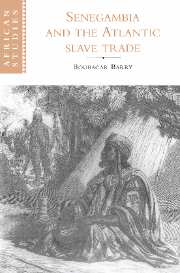Book contents
- Frontmatter
- Contents
- Preface
- Map
- I Senegambia from the fifteenth to the seventeenth century: a haven for incoming populations, a station for migrants on the move
- II Senegambia in the eighteenth century: the slave trade, ceddo regimes and Muslim revolutions
- III Senegambia in the first half of the nineteenth century: legitimate trade and sovereignty disputes
- IV Senegambia in the second half of the nineteenth century: colonial conquest and resistance movements
- Conclusion
- Notes
- Bibliography
- Index
- Other books in the series
Preface
Published online by Cambridge University Press: 31 October 2009
- Frontmatter
- Contents
- Preface
- Map
- I Senegambia from the fifteenth to the seventeenth century: a haven for incoming populations, a station for migrants on the move
- II Senegambia in the eighteenth century: the slave trade, ceddo regimes and Muslim revolutions
- III Senegambia in the first half of the nineteenth century: legitimate trade and sovereignty disputes
- IV Senegambia in the second half of the nineteenth century: colonial conquest and resistance movements
- Conclusion
- Notes
- Bibliography
- Index
- Other books in the series
Summary
This book is not about the Senegambian Confederation that brought present-day Senegal and Gambia together after the Kaur Conference of 1981. It is about the Greater Senegambia region, that vast stretch of territory covering the two great river basins, the Senegal and the Gambia River valleys, understood as an inclusive region beginning at the sources of the two rivers high on the Futa Jallon plateau, and ending at their mouths on the Atlantic coast. It comprises a West African region bordered by the Atlantic Ocean, the Sahara desert, the Savanna grasslands and the Equatorial forest.
In times past this region embraced all the states that now share the area: Senegal, Gambia, Guinea Bissau, as well as parts of Mauritania, Mali, and Guinea Conakry. Each of these six nation-states falls, wholly or in part, within the Greater Senegambian zone. All are now confronted, after a quarter century of independence, with a serious teething crisis threatening, in the long run, to block all likelihood of the region's population ever freeing itself from chronic underdevelopment and its grotesque sequel, negative development. Responses to the impasse, sad to say, have been unimaginative: a proliferation of such white elephants as the Senegal River Valley Development Authority (OMVS), the Gambia River Valley Development Authority (OMVG), the Sahel Region Inter-State Anti-Drought Committee (CILSS), the West African Economic Community (CEAO), and the Economic Community of West African States (ECOWAS).
- Type
- Chapter
- Information
- Senegambia and the Atlantic Slave Trade , pp. xi - xxiPublisher: Cambridge University PressPrint publication year: 1997

